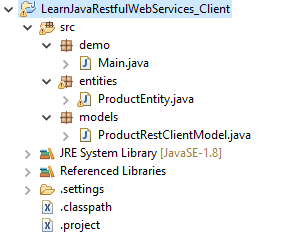Java Libraries
Use JAR files which are listed below:
antlr-2.7.7.jar
asm-3.1.jar
commons-logging-1.1.3.jar
dom4j-1.6.1.jar
genson-1.3.jar
hibernate-commons-annotations-4.0.2.Final.jar
hibernate-core-4.2.5.Final.jar
hibernate-jpa-2.0-api-1.0.1.Final.jar
jackson-core-asl-1.9.2.jar
jackson-jaxrs-1.9.2.jar
jackson-mapper-asl-1.9.2.jar
jackson-xc-1.9.2.jar
javassist-3.15.0-GA.jar
javax.servlet.jsp.jstl-1.2.2.jar
javax.servlet.jsp.jstl-api-1.2.1.jar
jboss-logging-3.1.0.GA.jar
jboss-transaction-api_1.1_spec-1.0.1.Final.jar
jersey-client-1.18.jar
jersey-core-1.18.jar
jersey-json-1.19.3.jar
jersey-server-1.18.jar
jersey-servlet-1.18.jar
jettison-1.1.jar
jsr311-api-1.1.1.jar
mysql-connector-java-5.1.36.jar
taglibs-standard-impl-1.2.1.jar
Create Database
Create a database with the name is learnjavarestfulwebservices. This database have a table: product table.
--
-- Table structure for table `product`
--
CREATE TABLE `product` (
`id` int(11) NOT NULL PRIMARY KEY AUTO_INCREMENT,
`name` varchar(250) NOT NULL,
`price` decimal(10,1) NOT NULL,
`quantity` int(11) NOT NULL,
`status` tinyint(1) NOT NULL,
`creationDate` date NOT NULL
) ENGINE=InnoDB DEFAULT CHARSET=utf8 COLLATE=utf8_unicode_ci;
--
-- Dumping data for table `product`
--
INSERT INTO `product` (`name`, `price`, `quantity`, `status`, `creationDate`) VALUES('name 1', '12.2', 2, 1, '2017-12-28');
INSERT INTO `product` (`name`, `price`, `quantity`, `status`, `creationDate`) VALUES('name 2', '6.5', 6, 0, '2017-12-29');
INSERT INTO `product` (`name`, `price`, `quantity`, `status`, `creationDate`) VALUES('name 3', '11.8', 8, 1, '2017-12-18');
Structure of Product Table

Data of Product Table

Entities Class
Create 2 entities classes – Product.java and ProductEntity.java, to represent the above tables
Product.java
package entities;
import java.io.Serializable;
import java.math.BigDecimal;
import java.util.Date;
import javax.persistence.Column;
import javax.persistence.Entity;
import javax.persistence.GeneratedValue;
import javax.persistence.GenerationType;
import javax.persistence.Id;
import javax.persistence.Table;
import javax.xml.bind.annotation.XmlRootElement;
@Entity
@Table(name = "product")
@XmlRootElement(name = "product")
public class Product implements Serializable {
@Id
@GeneratedValue(strategy = GenerationType.IDENTITY)
@Column
private int id;
private String name;
private BigDecimal price;
private int quantity;
private boolean status;
private Date creationDate;
public int getId() {
return id;
}
public void setId(int id) {
this.id = id;
}
public String getName() {
return name;
}
public void setName(String name) {
this.name = name;
}
public BigDecimal getPrice() {
return price;
}
public void setPrice(BigDecimal price) {
this.price = price;
}
public int getQuantity() {
return quantity;
}
public void setQuantity(int quantity) {
this.quantity = quantity;
}
public boolean isStatus() {
return status;
}
public void setStatus(boolean status) {
this.status = status;
}
public Date getCreationDate() {
return creationDate;
}
public void setCreationDate(Date creationDate) {
this.creationDate = creationDate;
}
}
ProductEntity.java
package entities;
import java.io.Serializable;
import java.math.BigDecimal;
import javax.xml.bind.annotation.XmlRootElement;
@XmlRootElement(name = "productEntity")
public class ProductEntity implements Serializable {
private int id;
private String name;
private BigDecimal price;
private int quantity;
private boolean status;
private String creationDate;
public int getId() {
return id;
}
public void setId(int id) {
this.id = id;
}
public String getName() {
return name;
}
public void setName(String name) {
this.name = name;
}
public BigDecimal getPrice() {
return price;
}
public void setPrice(BigDecimal price) {
this.price = price;
}
public int getQuantity() {
return quantity;
}
public void setQuantity(int quantity) {
this.quantity = quantity;
}
public boolean isStatus() {
return status;
}
public void setStatus(boolean status) {
this.status = status;
}
public String getCreationDate() {
return creationDate;
}
public void setCreationDate(String creationDate) {
this.creationDate = creationDate;
}
}
Hibernate Configuration File
Puts Product.java in your Hibernate configuration file, and also MySQL connection details.
<?xml version="1.0" encoding="UTF-8"?>
<!DOCTYPE hibernate-configuration PUBLIC "-//Hibernate/Hibernate Configuration DTD 3.0//EN"
"http://hibernate.sourceforge.net/hibernate-configuration-3.0.dtd">
<hibernate-configuration>
<session-factory>
<property name="hibernate.enable_lazy_load_no_trans">true</property>
<property name="hibernate.connection.driver_class">com.mysql.jdbc.Driver</property>
<property name="hibernate.connection.url">jdbc:mysql://localhost:3306/learnjavarestfulwebservices</property>
<property name="hibernate.connection.username">root</property>
<property name="hibernate.connection.password">123456</property>
<property name="hibernate.dialect">org.hibernate.dialect.MySQLDialect</property>
<property name="hibernate.current_session_context_class">thread</property>
<mapping class="entities.Product" />
</session-factory>
</hibernate-configuration>
Create HibernateUtil class
The HibernateUtil class helps in creating the SessionFactory from the Hibernate configuration file. The SessionFactory is threadsafe, so it is not necessary to obtain one for each thread.
package models;
import org.hibernate.*;
import org.hibernate.boot.*;
import org.hibernate.boot.registry.*;
public class HibernateUtil {
private static final SessionFactory sessionFactory;
static {
try {
StandardServiceRegistry standardRegistry = new
StandardServiceRegistryBuilder()
.configure("hibernate.cfg.xml")
.build();
Metadata metaData = new MetadataSources(
standardRegistry)
.getMetadataBuilder()
.build();
sessionFactory = metaData.getSessionFactoryBuilder().build();
} catch (Throwable th) {
throw new ExceptionInInitializerError(th);
}
}
public static SessionFactory getSessionFactory() {
return sessionFactory;
}
}
Create ProductModel class
The ProductModel class contains methods to interact with the database.
package models;
import org.hibernate.Session;
import org.hibernate.SessionFactory;
import org.hibernate.Transaction;
import entities.Product;
public class ProductModel {
private SessionFactory sessionFactory = HibernateUtil.getSessionFactory();
public boolean delete(int id) {
boolean result = true;
Session session = null;
Transaction transaction = null;
try {
session = sessionFactory.openSession();
transaction = session.beginTransaction();
Product product = (Product) session.get(Product.class, id);
session.delete(product);
transaction.commit();
} catch (Exception e) {
result = false;
if (transaction != null) {
transaction.rollback();
}
} finally {
session.close();
}
return result;
}
}
Create Server Project
Create Dynamic Web Project in Eclipse. Copy all jar files above to the lib directory in the project

Create ApplicationConfig Class
This class is used to register a URL pattern in Jersey to intercept HTTP calls to the service. The marshaller, Jersey intercepts the path given in @ApplicationPath annotation such as – @ApplicationPath(“api”). This class extends javax.ws.rs.core.Application. All the RESTful web services and extensions needed are registered here.
ApplicationConfig.java
package ws;
import java.util.Set;
import javax.ws.rs.core.Application;
@javax.ws.rs.ApplicationPath("api")
public class ApplicationConfig extends Application {
@Override
public Set<Class<?>> getClasses() {
Set<Class<?>> resources = new java.util.HashSet<>();
addRestResourceClasses(resources);
return resources;
}
private void addRestResourceClasses(Set<Class<?>> resources) {
resources.add(controllers.ProductRestController.class);
}
}
Create Restful Web Services
Create Restful Web Services provides application/json data for the client
package controllers;
import javax.ws.rs.DELETE;
import javax.ws.rs.Path;
import javax.ws.rs.PathParam;
import javax.ws.rs.core.Response;
import models.ProductModel;
@Path("product")
public class ProductRestController {
@DELETE
@Path("delete/{id}")
public Response delete(@PathParam("id") int id) {
try {
ProductModel productModel = new ProductModel();
boolean result = productModel.delete(id);
return Response.ok(String.valueOf(result)).build();
} catch (Exception e) {
return Response.status(Response.Status.BAD_REQUEST).build();
}
}
}
Consume Restful Web Services from Java Application
Create Java Project in Eclipse. Add all jar files above to the project

Entity Class
Create entities package in client project. Create a entity class: ProductEntity.java as below
ProductEntity.java
package entities;
import java.io.Serializable;
import java.math.BigDecimal;
import javax.xml.bind.annotation.XmlRootElement;
@XmlRootElement(name = "productEntity")
public class ProductEntity implements Serializable {
private int id;
private String name;
private BigDecimal price;
private int quantity;
private boolean status;
private String creationDate;
public int getId() {
return id;
}
public void setId(int id) {
this.id = id;
}
public String getName() {
return name;
}
public void setName(String name) {
this.name = name;
}
public BigDecimal getPrice() {
return price;
}
public void setPrice(BigDecimal price) {
this.price = price;
}
public int getQuantity() {
return quantity;
}
public void setQuantity(int quantity) {
this.quantity = quantity;
}
public boolean isStatus() {
return status;
}
public void setStatus(boolean status) {
this.status = status;
}
public String getCreationDate() {
return creationDate;
}
public void setCreationDate(String creationDate) {
this.creationDate = creationDate;
}
}
Create DemoRestClientModel
DemoRestClientModel class contain methods call restful web services
package models;
import javax.ws.rs.core.MediaType;
import com.sun.jersey.api.client.Client;
import com.sun.jersey.api.client.ClientResponse;
import com.sun.jersey.api.client.WebResource;
import com.sun.jersey.api.client.config.DefaultClientConfig;
public class ProductRestClientModel {
private String BASE_URL = "http://localhost:8080/LearnJavaRestfulWebServices_Server/api/";
private WebResource webResource;
private Client client;
public ProductRestClientModel() {
this.client = Client.create(new DefaultClientConfig());
this.webResource = this.client.resource(BASE_URL).path("product");
}
public ClientResponse delete(int id) {
ClientResponse response = null;
try {
WebResource resource = this.webResource;
response = resource.path("delete/" + id)
.accept(MediaType.APPLICATION_JSON)
.delete(ClientResponse.class);
} catch (Exception e) {
response = null;
}
return response;
}
}
Run It
package demo;
import com.sun.jersey.api.client.ClientResponse;
import models.ProductRestClientModel;
public class Main {
public static void main(String[] args) {
ProductRestClientModel productRestClientModel = new ProductRestClientModel();
ClientResponse response = productRestClientModel.delete(4);
if (response != null) {
int statusCode = response.getStatus();
System.out.println("Response Status: " + statusCode);
boolean result = response.getEntity(Boolean.class);
System.out.println("Result: " + result);
} else {
System.err.println("Can not access create web method");
}
}
}
Output
Response Status: 200
Result: true


